You can’t consider yourself a carpet connoisseur if you have never heard about Persian rugs. Carpet lovers evaluate Persian rugs for their high durability, unusual patterns, and bright colors. Mostly, these rugs are high-pile woven ones. The older the Persian rug is, the more precious it is. But how to determine the Persian rug age?
To determine Persian rug age, pay attention to these 3 factors: 1. The color palette, 2. The material it is made of, 3. Its pattern. You can find Persian rugs made about 100 years ago in modern American homes. Such rugs are mostly made of silk or wool. Their color palette is neutral and they are painted with vegetable dyes. The patterns on such rug surfaces are geometric or floral. Read further to know, how Persian rugs are classified according to their age groups.
Defining the Age of Persian Rugs: 5 General Rules
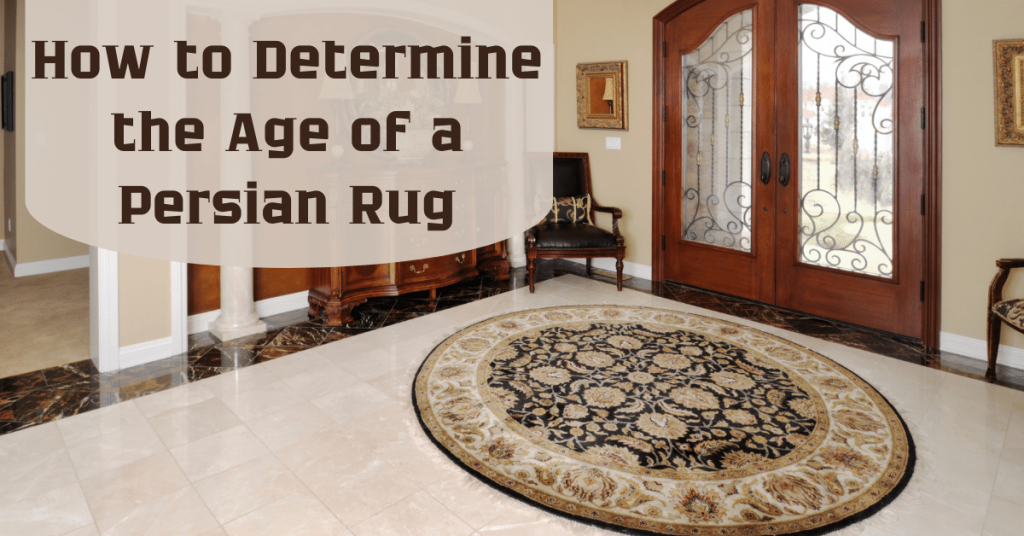
For my readers to navigate the world of antique Persian rugs, I want to share 5 general rules, which help to define the age of these textile items.
1. Hire a professional to determine the age of your Persian rug
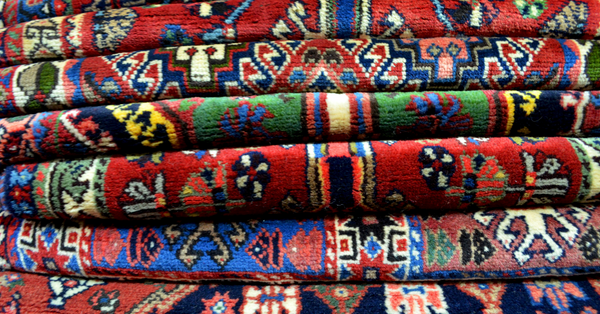
I know that it seems quite shocking I start the list of rules to define the age of Persian rugs from the advice to hire a specialist to help you. But you should know that the price of the Persian rug depends on its age. Thus, if you don’t know, how to determine the age of your textile item, you may become the victim of fraud.
You may give thousand of hundreds of dollars for the low-cost carpet, which has no historical; value. So, if you plan to buy a really expensive item for $10, 000 or more, or if you inherited the Persian rug from your grandparents and don’t know its value, I advise you to hire a professional. In this case, you can be sure, you didn’t go wrong and determined the Persian Rug age correctly.
2. Go to the nearest rug shops and compare the Persian items
To determine the age of the Persian rug precisely, you should have a well-trained eye. For that, I recommend you to several nearest shops, where Persian rugs are sold. Watch at them, read their care tags, and find out their age. Take some time and talk to the shop assistant about the age of the rugs he has in his shop. Gradually, you’ll notice that the rugs, which relate to the same measure of time, have a lot in common. Thus, you’ll be able to define the age of your Persian rug quite precisely.
3. See, if the Persian rug has any signs of wear
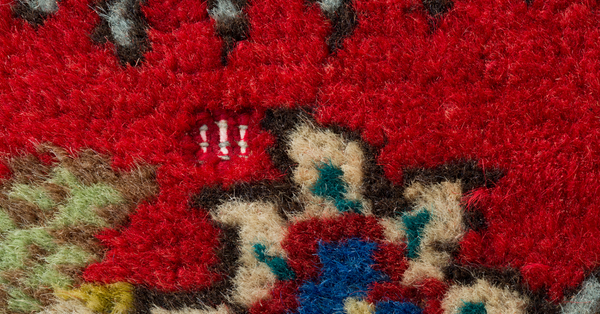
Keep in mind that even a 10-year-old Persian rug should have some signs of wear. So, examine the piece you have thoroughly. Look at the rug edges. They should be ragged. Probably, they have some torn treads or clues. The signs of wear are evidence that the rug is old enough.
4. Look at the colors of your Persian rug
One of the main things, which helps to define the rug’s age is its color. The old Persian rugs contain natural vegetable colors only. Modern Persian carpet manufacturers can’t replicate the old colors exactly.
5. Define the material of your Persian rug
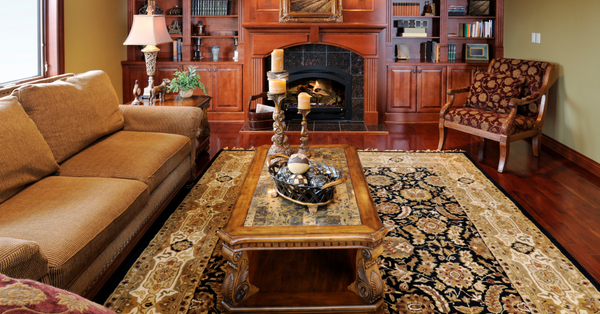
The way the Persian carpet feels when you touch it is one of the first marks, which help define its age. The surface of an old Persian rug is wetter and softer than modern ones. Besides, old Persian rugs are always made of natural materials, like wool or silk.
These general rules will help you identify the age of the Persian rug fast. But if you need to go deeper into this topic, let’s see, how we classify the Persian rugs according to their age.
Classification of Persian Rugs According to Their Age
Look at the table to determine, to which age group the Persian rug belongs.
| New Persian Rugs | Up to 5 years old |
| Used Persian Rugs | 6-10 years old |
| Semi-old Persian Rugs | 10-50 years old |
| Old Persian Rugs | 50-90 years old |
| Semi-antique Persian Rugs | 90-100 years old |
| Antique Persian Rugs | 100+ years old |
| Collectible Persian Rugs | 18-19th century of production |
| Museum Persian Rugs | 13-18th century of production |
Museum and Collectible Persian Rugs
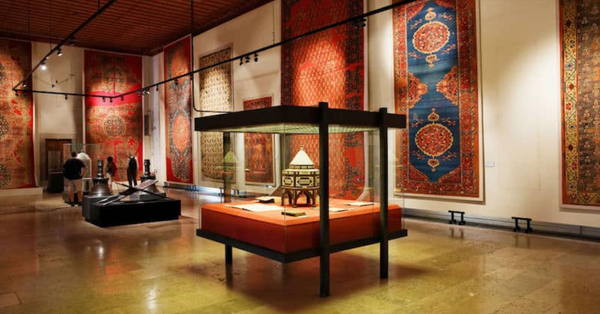
As you can see from the table, the oldest Persian rugs were made in the 13-18th century. The Persians knew how to weave the carpets 7-8 centuries ago. At that time Persian (or Iranian) rugs became the most famous in the world. The rugs were produced in Iran (historically it was called “Persia”) in special workshops in towns and villages. Very often carpet weaving was the family business. The secrets of creating the best rugs were kept so thoroughly and passed from the father to the son.
There were Persian rug manufacturers at the royal court. The rugs, made for the noblest and richest Persian people, were unique. Very often they were decorated with gold threads and precious stones.
The golden era of Persian carpet making took place in the 16-18th century. The carpet weaving connoisseurs call this period “The Golden Age of Persian Rugs”. During this time the Safavid dynasty ruled Persia. The rulers of this dynasty sponsored carpet-making workshops. The Persian rugs, produced in the “capital of carpet weaving” – Isfahan – were real art pieces. After the lifting of the religious ban to depict animals and birds in pictures etc, the patterns of the rugs became closely connected with nature. The Persian rugs of that period became a sensation among European rich men.
Nowadays, the Persian rugs of the Safavid epoch are located in museums. You can also find them in the collections of Iranian and European billionaires. Thus, one of the Persian carpets, the Kirman rug, was sold for $33 million at an auction in 2013.
Of course, the Persian rug you have is not as expensive as the antique ones. Nevertheless, the rug, which you found in the attic of your grandmother’s house can cost up to $100, 000. But only in case, it was made in the Persian regional centers Qum or White Kashan.
Semi-Antique Persian Rugs
For many centuries carpet production in Persia was in decline. But in the 1920s carpet weaving began developing again. That was possible due to the efforts of Reza Pahlavi, the Shah of Iran. Shah Reza Pahlavi was a great supporter of carpet weaving traditions and he greatly contributed to the revival of the industry.
In the first part of the 20th century, the most valuable Persian Rugs were produced in such Iranian regional centers as Qum and White Kashan.
Persian Rugs from Qum
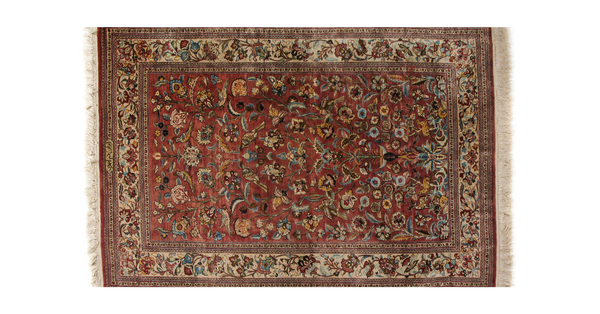
If you inherited the Qum Persian rug, you may be sure you are one of the most expensive luxurious items. The age of the Qum rug is about 100 years old.
Colors
They are different from the others in their neutral color palette. Unlike earlier Persian rugs, the ones produced in calm are of the beige, light brown, or green color palette.
Materials
Qum rugs are different from the others by the material they are made of, too. Very often the manufacturers weaved these rugs from silk. These rugs are very light and fragile.
Patterns
Persian Rugs from Qum have unusual patterns, too. Usually, they are decorated with geometric ornaments. Sometimes such Persian carpets contain floral patterns. The fact is that Iranian carpet masters targeted wealthy European and American consumers. Therefore, they refused the bright colors and religious plots traditional to Iran. They created their textile masterpieces in a more modern western manner.
Persian Rugs from White Kashan
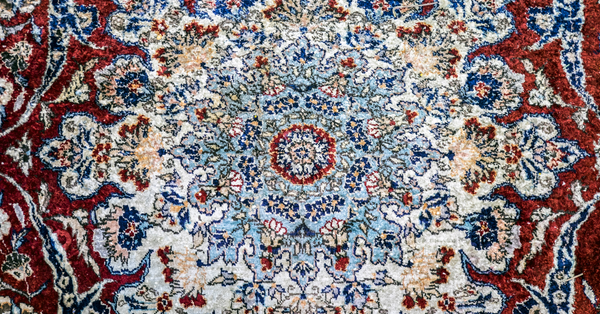
It’s also possible, that the old Persian rug you got from your grandparents or found in the local second-hand store, is also 100 years old. And manufacturers from White Kashan created this masterpiece. To determine exactly your rug’s age and origin, look at its colors, pattern, and material.
Colors
The Persian rug, produced in the 20th century in White Kashan, always contain red color. It can be mixed with black, light blue, or brown.
Materials
Mostly, White Kashan Persian rugs are made of wool. They are handmade.
Patterns
The White Kashan rugs contain floral patterns.
Used and New Persian Rugs
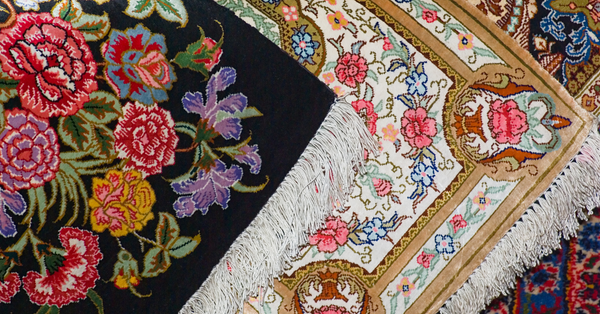
Used and new Persian rugs are less expensive than antique and semi-antique. No wonder, because modern Persian rugs are not always handmade and produced from natural materials. Nevertheless, they cost a pretty penny, too. The matter is, in 2010 they limited the importation of Persian carpets to the USA. Thus, each Persian rug is quite expensive on the American market.
Conclusion
To wrap up, it’s very hard to define precisely the age of the Persian rug by yourself. In some cases, it is better to hire a professional or to consult an assistant from the nearest rug shop. Nevertheless, if you want to do it yourself, pay attention to the material the rug is made of, to its color palette and pattern. Each historical period in Persia had its traditions of carpet weaving. But even relatively new Persian rugs are valuable and beautiful. So, in any case, you are the owner of the textile masterpiece.
